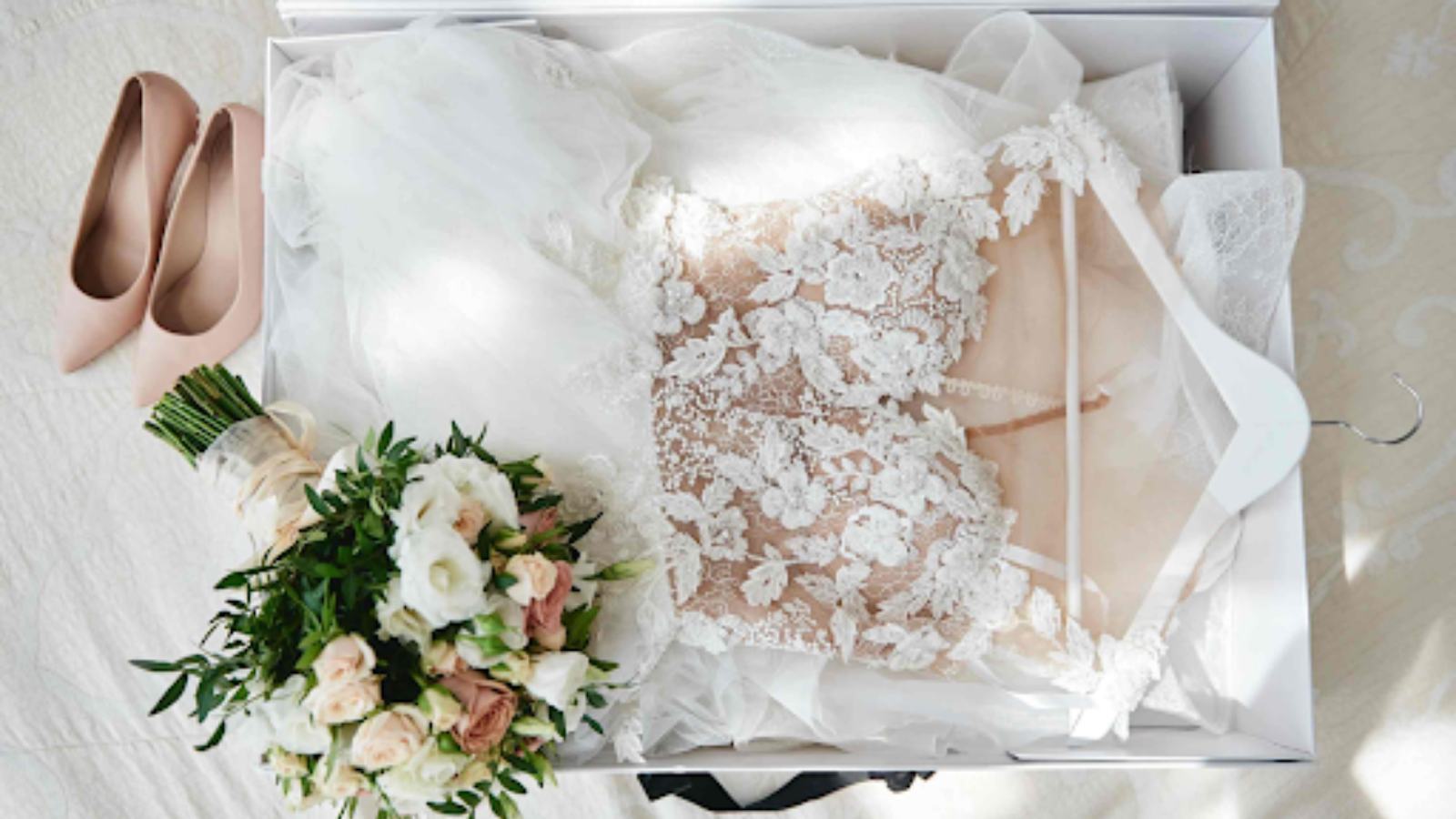So, the big day’s over!
Now you are not just the proud owner of a gorgeous wedding dress – you are its guardian for life and beyond!
Because it’s a keepsake worth preserving, don’t just toss it in a plastic bridal gown bag or hang it in your closet.
It deserves more than that!
Improper storage can have irreversible consequences– yellowing, wrinkles, fabric weakening, mold growth, and more!
Light, humidity, storage place, and even how you fold your gown play key roles in how well it holds up over time.
Hence, proper wedding dress storage is the only key to keeping your dress safe and spotlessly flawless for decades!
Every step counts, from cleaning before packaging to choosing the right space to regular monitoring. This blog is your ultimate guide, with all the information you need to keep your wedding gown’s beauty lasting a lifetime.
Let’s take a look!
How to Store a Wedding Dress for Long-Term Preservation

Tossing your wedding gown in a box or leaving it in a bag might seem easy, but those shortcuts can lead to yellowing, stains, or even tears.
However, when you follow the right approach to wedding gown storage, it can stay soft, white, magical, and full of meaning even for decades. This way, someday, you might wear it again or share it with a loved one - just as perfect as ever!
Let’s get into it!
1. Cleaning Your Wedding Dress: First and Most Crucial Step
Thinking, what’s so big deal with wedding dress cleaning and preservation?
Well, consider cleaning the first thing you must take care of before even deciding to preserve your gown.
Why? Because it’s not just about looking good; it’s about longevity.
Even one of the most stunning and classic wedding dresses can yellow, weaken, or stain beyond repair without proper treatment.
Also, this step must be handled with care, as different fabrics and embellishments require specific cleaning methods.
Visible vs. Invisible Stains
When most people think of cleaning their bridal dresses, they picture only getting rid of stains visible to the naked eye.
But the real danger often lies in what you can’t see, right?
| Type of Stain | Examples | Characteristics |
|---|---|---|
| Visible Stains | Dirt, grass, makeup marks, food and drink spills | Easy to spot; they appear immediately after the event |
| Invisible Stains | Perspiration, body oils, perfume, and hairspray | Hard to see, as they don’t leave an immediate mark, but cause irreparable damage |
Cleaning Methods: Wet vs. Dry
To preserve the quality of your bridal dress, you must choose the correct cleaning method. The two primary methods are wet cleaning and dry cleaning.
| Cleaning Method | When to Use | Benefits | What It Involves |
|---|---|---|---|
| Wet Cleaning | Suitable for fabrics like cotton, silk, and tulle | Effectively removes visible stains; gentle on natural fabrics | Uses water and specialized detergents in a controlled process |
| Dry Cleaning | Best for fabrics like satin, organza, and those with heavy embellishments | Modern solvents are safe and effective on most fabrics | Uses gentle liquid solvents instead of water |
⚠️ Quick Warning:
Avoid DIY cleaning at home!
Stain removers, steamers, and washing machines can cause more harm than good if not used appropriately. Leave this job to professionals like the ones we have at Dress Preservation!
Professional Cleaning Considerations
While it may sound easy to skip professional cleaning to save time or money, doing so can cost you more in the long run.
A qualified, professional wedding dress cleaner has the expertise to:
-
Understand and treat different kinds of wedding gown fabrics.
-
Work with specialized stain treatments.
-
Handle delicate embellishments.
-
Employ archival-safe packaging options.
So, don’t trust any random, local dry cleaner with your precious treasure. We at DressPreservation.com employ the best professionals who have the required experience and knowledge to handle your wedding attire with the care it demands.
2. Archival-Quality Storage: The Foundation of Longevity

1. What is the best way to store a wedding dress?
2. Should I hang my wedding dress or lay it flat?
3. Can I store my wedding dress in a plastic box?
4. Is it better to store a wedding dress in a bag or a box?
If these questions have been swirling in your head (and of course your Google history) when looking for answers on how to store a wedding dress, you are not alone!
Storing your wedding dress is just as important as cleaning it.
In this section, we’ll explore why typical storage solutions fail and what archival-quality materials you should use to keep your gown looking flawless for decades.
Why Household Storage Methods Fail
Here’s a quick table to understand why household storage methods can often cause more damage than protection:
| Household Storage Method | Why It Fails | Potential Damage to Dress |
|---|---|---|
| Plastic Bags | Traps moisture and doesn’t allow fabric to breathe | Mildew growth, yellowing, and fabric deterioration |
| Vacuum Sealing | Compresses fibers and embellishments tightly | Permanent creases, crushed beads, misshaping |
| Non-Archival Cardboard Boxes | Contains acids and lignin that leach into fabric | Yellowing and weakening of fibers over time |
| Sealed Containers (Plastic/Non-Archival) | Traps off-gassing chemicals and moisture | Accelerated fabric breakdown, discoloration |
⚠️ Quick Warning:
If you want your wedding gown to breathe, avoid storing it in a plastic bag at any cost!
Archival Storage Materials
Now that we have covered what not to use, let’s talk about what actually works! If your goal is long-term storage, you must pick the right material that protects your dress not only for decades, but even for centuries!
| Material Type | Purpose & Benefits | Use Cases |
|---|---|---|
| Acid-Free, Lignin-Free Tissue Paper | Prevents acid damage and yellowing, protects delicate fabrics | Ideal for wrapping and padding dresses |
| Buffered Tissue Paper | Neutralizes acids, great for most fabrics except sensitive ones | Use for cotton, polyester, and blends |
| Unbuffered Tissue Paper | Avoids chemical reactions, best for delicate fabrics like silk and acetate | Use for sensitive fabrics only |
| Acid-Free, Archival-Quality Boxes | Protect fabric from light, dust, and environmental pollutants | Use for flat storage of the entire gown |
Flat Boxing vs. Hanging: What to Pick
Whether to hang or box your wedding dress depends on the fabric type and the gown’s structure. Let’s quickly compare both methods with the simplified table below to help you decide better!
| Aspect | Flat Boxing | Hanging |
|---|---|---|
| Fabric Preservation | Minimizes stress on seams and fabric; helps prevent stretching | May cause stretching, particularly for heavier fabrics |
| Shape Retention | Maintains the gown's shape with proper folding and padding | Maintains shape, but can distort with time due to gravity |
| Space Requirement | Requires more storage space | Takes up less space, ideal for smaller spaces |
| Access to Dress | Dress is securely packed away, less accessible | Easier to access and view the gown |
| Protection from Light/Dust | Protects gown from light, dust, and pollutants | Exposed to light and dust, which can damage the fabric over time |
| Best For | Dresses with delicate fabrics, embellishments, and heavy skirts | Lightweight dresses or gowns that are not affected by gravity and stretching |
Flat boxing is generally the preferred method because, as explained earlier, it minimizes stress on seams and prevents the fabric from unnecessary stretching.
And, in case you opt for one, here are a few tips to help you fold and pad your gown with ease:
✅ Use acid-free tissue paper to cushion every fold gently.
✅ Avoid tight or sharp folds; gently fold in natural seams or pleats whenever possible.
✅ Provide generous padding in areas like sleeves, bodice, and skirt folds to maintain shape.
✅ Store the box in a cool, dark, dry place away from direct sunlight and humidity fluctuations.
3. The Ideal Storage Environment: Climate Control Essentials
Proper storage isn’t just about boxing it carefully; it’s also about the space around it. Without proper climate control, even the most carefully packed and stored dresses can deteriorate over time.
Temperature and Humidity: The Most Critical Factors
✅ Ideal temperature range: 65–75°F (18–24°C)
✅ Ideal relative humidity: Anywhere between 40–55%
🔍Why does it matter?
-
Fluctuations in temperature and humidity can cause fabric to swell or become brittle over time.
-
Mold risk increases in environments with excessive moisture or rapid changes in humidity.
-
Stability prevents long-term fabric damage and maintains the gown’s beauty.
Achieving Climate Control at Home
Achieving the right climate at home doesn’t require complex systems—simple tools can make a big difference.
✅ Use central HVAC systems to maintain a steady room temperature.
✅ In humid areas, run a dehumidifier; in dry climates, use a humidifier.
✅ Add a small fan for gentle air circulation to prevent mold buildup.
✅ Include silica gel packets inside the storage box to manage microclimate moisture.
4. Light Protection: Guarding Against the Invisible Enemy
Light, particularly UV rays from sunlight or fluorescent bulbs, can silently fade and weaken your wedding dress over time. This damage is often invisible until it’s too late. Hence,
✅ Store your gown in a cool, dark spot away from windows.
✅ Use lightproof archival boxes for total UV shielding.
✅ If storing in a room with windows, consider installing blackout curtains or UV filters.
5. Pest Prevention: Protecting Your Gown from Insects
Pests like clothes moths and carpet beetles see natural fibers as food. Once they attack, the damage often becomes irreversible.
But what attracts them?
It’s clearly Warmth, Humidity, Dust, or Leftover Stains.
✅ Smart Prevention Tips:
-
Keep the storage area clean and dry
-
Ensure good air circulation
-
Use window/vent screens to block entry
-
Store the gown off the floor to reduce the risk
-
Vacuum storage surrounding regularly
6. Choosing the Right Storage Location at Home
Recommended Storage Spots
✅ Interior closets (away from exterior walls, windows, vents)
✅ Under-bed storage with archival boxes (only if climate stable)
✅ Dedicated climate-controlled rooms or professional storage units
Locations to Avoid
✅ Attics and basements (extreme temp/humidity, pests)
✅ Bathrooms and kitchens (humidity & temperature swings)
✅ Direct floor placement (dust and pests risk)
✅ High traffic areas where it might get bumped or damaged.
7. Long-Term Care: Monitoring and Maintenance
Storing your wedding dress safely is just the beginning!
If you want your dress to look flawless, just as it did the day you wore it while walking down the aisle, regular checkups become a non-negotiable move.
Frequency and Importance of Inspections
✅ How often? Every 6–12 months
✅ Why inspect regularly? Because it can:
-
Catch early signs of yellowing, staining, or fabric breakdown.
-
Detect pest activity before it causes damage.
-
Ensure structural elements (like seams and lace) remain intact.
-
Confirm storage conditions are still optimal.
Must-Know Inspection Tips
During each inspection, pay attention to the following:
✅ Signs of damage: yellowing, fading, stains, stretching, loose embellishments
✅ Check for mold, mildew, and pests.
✅ Always wear clean white cotton gloves to avoid transferring oils and dirt.
✅ Refresh acid-free tissue paper to maintain cushioning and prevent creases.
✅ Refill/add padding in areas like sleeves and bodices to support the dress’s shape.
✅ Vacuum the surrounding area to minimize dust buildup.
✅ After inspection, ensure the archival box is properly resealed.
When to Seek Professional Preservation Services
DIY storage might seem like a convenient option, but the truth is that professional preservation is always one step ahead in maintaining your gown’s original glory.
Consider a professional cleaning and storage service in case:
-
It’s vintage!
-
If it’s heavily embellished.
-
Your gown is made of delicate fabric.
-
There are stubborn stains or yellowing.
-
You lack a safe, stable space at home.
-
You want acid-free, climate-controlled, expert storage conditions.
-
You plan to pass it down to the next generation.
At DressPreservation.com, we have been perfecting the art of bridal gown care since 1913! We are renowned for using the safest and gentle SystemK4 cleaning technology, acid-free packing materials, and premium preservation chests.

So, don’t leave your wedding gown to chance! Trust the experts who have stored and preserved over 3 million gowns and counting!
Conclusion: Preserving a Cherished Legacy
Storing your wedding dress isn’t just about keeping the fabric intact; it’s more about honoring what that dress represents.
Every step—from expert cleaning to safe storage to regular inspections—is crucial in protecting its beauty and integrity. And, while you can do a lot on your own, some things turn out better when left to the professionals.
So, when you want the very best for your dress, trust our experts who have made it their mission to preserve your story!
Because your wedding dress deserves nothing less!
Frequently Asked Questions
How to store a wedding dress at home?
Store your wedding dress in a cool, dry, dark place using acid-free materials. Keep it flat in an archival box, away from light and moisture.
How to store a wedding dress before the big day?
Keep your gown in a garment bag and hang it safely in a cool, dry place. Make sure it’s in a clean area away from sunlight and dust.
How to store a wedding dress so it doesn't yellow?
If you want your dress to stay spotlessly white, avoid plastic containers, as they can trap moisture. Opt for breathable, acid-free storage solutions and keep them in a stable, low-humidity environment.
Is it better to store a wedding dress hanging or flat?
For long-term storage, the flat method is usually better to avoid stress on the fabric. Hanging works short-term if done carefully with good support.
Can I store my wedding dress in a plastic box?
FIdeally, you should avoid keeping your dress in a plastic box. But if you have to, choose one made for archival use and add moisture-absorbing packets. Avoid regular plastic containers.
How much does it cost to store a wedding dress?
The cost to store a wedding dress professionally typically ranges from $200 to $500, depending on the level of preservation, packaging, and materials used.
Can I store my wedding dress in a vacuum bag?
It’s not at all recommended! Vacuum sealing can cause creases, crush delicate fabrics, and lead to long-term damage.
Can you fold a wedding dress for storage?
Yes, just be gentle. Use acid-free tissue paper to cushion folds and refold differently during checkups to prevent permanent creases.








